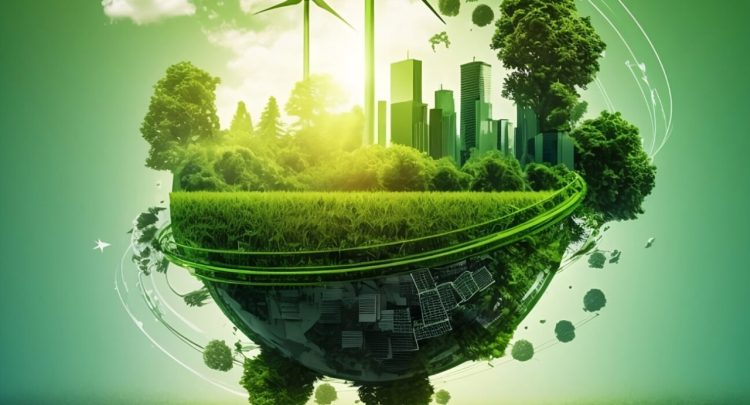In today’s world, technology is no longer just a tool for enhancing convenience or productivity. It has become an essential vehicle for tackling some of the most pressing challenges of our time, including climate change, resource depletion, and social inequality. The driving forces behind the development and adoption of these technologies are not limited to the urgent need for environmental protection but also include the growing economic benefits and an increasing sense of social responsibility across sectors. Together, these elements create a powerful impetus for innovation, sustainability, and the responsible use of resources.
In this article, we will explore how the demands of environmental protection, the potential for economic gains, and a growing focus on corporate social responsibility (CSR) are driving technological advancements across various sectors. From clean energy to waste management and beyond, the interplay between these forces is transforming industries and reshaping our approach to development, governance, and societal progress.
1. Environmental Protection as a Driving Force for Technological Innovation
1.1 The Urgency of Environmental Challenges
The global environmental landscape is under intense pressure, driven by issues such as climate change, pollution, deforestation, and biodiversity loss. As the world’s population grows and industrialization expands, the need to address these challenges has never been more urgent. According to the United Nations, human activities have caused unprecedented damage to the planet, and without concerted efforts to mitigate these effects, the future of both our environment and economy could be at risk.
The need to reduce carbon emissions, conserve natural resources, and protect ecosystems has become a primary motivator for the development of new technologies. Governments, businesses, and organizations are all seeking ways to reduce their environmental impact while maintaining or even improving productivity and profitability.
1.2 The Role of Technology in Environmental Protection
Technological innovations have proven to be key in addressing environmental challenges. From renewable energy sources to waste management systems and energy-efficient manufacturing, technology offers practical solutions that can reduce the environmental footprint of human activity. Some of the most impactful areas of technological development in this regard include:
- Renewable Energy Technologies: The global shift towards solar, wind, and hydropower as sustainable energy sources is one of the most significant ways technology is being leveraged for environmental protection. These energy sources provide clean alternatives to fossil fuels, significantly reducing greenhouse gas emissions and helping to mitigate climate change.
- Energy Efficiency and Smart Grids: Technological advancements in energy efficiency, such as energy-saving appliances, LED lighting, and smart grid systems, are transforming the way energy is consumed. Smart grids, for example, optimize electricity distribution, improve energy use efficiency, and reduce waste.
- Carbon Capture and Storage (CCS): CCS technologies are designed to capture carbon dioxide (CO2) emissions from industrial processes and store them underground, preventing them from entering the atmosphere and contributing to climate change. This technology could play a critical role in reducing emissions from industries that are hard to decarbonize, such as cement and steel production.
1.3 Circular Economy and Waste Management
In the realm of waste management, the circular economy model is gaining traction. Unlike the traditional linear economy, which follows a “take-make-dispose” pattern, the circular economy emphasizes reusing, recycling, and reducing waste. Technologies that facilitate this model, such as advanced recycling processes, waste-to-energy solutions, and biodegradable materials, are helping reduce the environmental impact of waste production.
- Recycling Innovations: New technologies in waste sorting, chemical recycling, and composting are allowing for more efficient recycling of materials like plastics, paper, and metals. These innovations make it easier to recycle and reuse materials, preventing them from ending up in landfills.
- Waste-to-Energy (WTE) Technologies: WTE technologies use waste as a resource, converting non-recyclable waste materials into energy. These technologies not only reduce waste but also generate power, reducing dependence on fossil fuels.
2. Economic Benefits Driving Technological Advancement
2.1 The Growing Market for Sustainable Technologies
The economic benefits of adopting environmentally friendly technologies are becoming increasingly clear. As concerns about climate change and resource depletion intensify, businesses are recognizing the need to invest in sustainability to remain competitive. A wide range of technological solutions, from clean energy to green construction and sustainable agriculture, offer significant cost savings, revenue generation opportunities, and long-term economic growth.
2.1.1 Cost Savings Through Energy Efficiency
One of the most compelling economic reasons for adopting green technologies is the potential for cost savings. For businesses, implementing energy-efficient systems, such as LED lighting, energy-efficient appliances, and automation technologies, can lead to significant reductions in operating costs. In the long term, energy-efficient buildings, machinery, and systems often result in lower energy consumption and lower utility bills.
- Smart Technologies and Automation: The integration of smart technologies, such as AI-powered energy management systems and automation tools, can optimize energy usage, reduce waste, and maximize efficiency, leading to substantial cost savings.
2.1.2 Green Jobs and Economic Growth
The rise of green technologies also leads to the creation of new jobs in the renewable energy sector, sustainable construction, green manufacturing, and environmental services. The transition to a low-carbon economy offers substantial employment opportunities, which can stimulate economic growth while simultaneously addressing environmental issues.
- Renewable Energy Jobs: According to the International Renewable Energy Agency (IRENA), renewable energy industries employed more than 12 million people worldwide in 2020. These industries continue to grow, providing job opportunities in sectors such as solar, wind, and energy storage.
- Sustainable Construction and Green Building Design: The demand for sustainable buildings is driving the growth of the green construction sector. Architects, engineers, and construction professionals with expertise in energy-efficient design, sustainable materials, and eco-friendly building practices are in high demand.
2.1.3 Long-Term Economic Resilience
Investing in sustainability and green technologies is also an important strategy for ensuring long-term economic resilience. As climate change accelerates, industries that are heavily reliant on fossil fuels or non-renewable resources face the risk of obsolescence, increased regulation, and rising operational costs. By adopting sustainable technologies now, companies can future-proof their operations and reduce their exposure to environmental and regulatory risks.
2.2 Green Technology Investment: A Growing Trend Among Corporations
The economic case for green technology is not just being recognized by small businesses and startups—it is also a growing trend among large corporations. From multinational companies to local enterprises, many are making strategic investments in sustainable technologies as part of their long-term business models. This trend is driven by several factors:
- Investor Pressure and ESG Goals: Investors are increasingly demanding that companies adopt sustainable practices and meet environmental, social, and governance (ESG) criteria. Companies that fail to align with these expectations risk losing access to capital or facing reputational damage.
- Government Incentives: Governments around the world are offering tax incentives, subsidies, and grants to encourage the adoption of green technologies. These financial incentives make it easier for companies to transition to renewable energy and sustainable practices.
- Brand Value and Consumer Loyalty: Consumers are increasingly prioritizing sustainability when making purchasing decisions. Companies that invest in green technologies and promote their commitment to environmental stewardship can enhance their brand reputation and attract a loyal customer base.

3. Corporate Social Responsibility (CSR): Technological Innovation as a Social Duty
3.1 The Rise of CSR and Technological Innovation
In recent years, corporate social responsibility (CSR) has evolved from a voluntary initiative to an essential component of business strategy. CSR refers to the ethical obligation that businesses have to contribute positively to society and the environment while achieving their financial goals. As technology continues to advance, businesses are recognizing that their role in social responsibility must include the adoption of sustainable and environmentally friendly practices.
CSR efforts often align with technological innovations in areas such as:
- Sustainable Supply Chain Management: Many companies are using technology to optimize their supply chains and reduce their environmental footprint. Digital tools, such as blockchain for transparency, AI for optimization, and IoT for monitoring, are being employed to ensure sustainability at every stage of production.
- Carbon Neutrality: Companies are increasingly adopting technologies that help them achieve carbon neutrality. These include renewable energy systems, carbon capture technologies, and carbon offset programs. Businesses are making public commitments to reduce their emissions, invest in green technologies, and contribute to global sustainability goals.
- Waste Reduction and Circular Economy: Corporations are integrating waste-reducing technologies into their operations, adopting circular economy principles, and rethinking product design to reduce environmental impact.
3.2 Social Responsibility Beyond the Environment
Corporate social responsibility also extends beyond environmental concerns to include social issues such as labor rights, community development, and access to education and healthcare. In many cases, technology is being used to address social challenges as well. For example, businesses are using digital platforms to promote financial inclusion, support education initiatives, and address global health challenges.
In the context of environmental protection, the integration of CSR with technological innovation offers an opportunity for companies to align their values with global sustainability goals, creating a more ethical and responsible business environment.
3.3 Government Regulations and Public Expectations
As societal expectations around sustainability increase, governments are introducing stricter regulations to ensure that companies adopt responsible practices. These regulations often require businesses to disclose their environmental impact, reduce their carbon footprint, and invest in green technologies. Companies that embrace these regulations as opportunities to innovate and lead in sustainable technology can enhance their reputation and attract a competitive edge in the market.
4. Conclusion: The Synergy of Environment, Economics, and Social Responsibility
The intersection of environmental protection, economic benefits, and corporate social responsibility is creating a powerful force driving technological innovation. As the world faces increasingly complex environmental challenges, the demand for sustainable technologies continues to grow. Businesses, driven by both profit motives and ethical considerations, are recognizing that adopting green technologies not only helps protect the planet but also offers significant long-term economic benefits.
Technology’s role in addressing these challenges is profound, and the synergy between environmental, economic, and social factors is shaping a future in which technological advancement is integral to creating a more sustainable, equitable, and prosperous world for future generations. By investing in and supporting green technologies, we are not only addressing urgent environmental crises but also laying the groundwork for a more resilient and inclusive global economy.












































